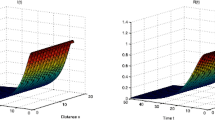Abstract
We study the existence and nonexistence of traveling waves of diffusive epidemic models with general incidence rates. The model systems are non-monotone because of the intrinsic predator–prey interaction between the susceptible and infective compartments in epidemic systems. Moreover, the incidence rate may not be monotone in the infected population because social behaviors and collective activities may change in response to the prevalence of disease. To find positive traveling solutions of the non-monotone system with a non-monotone incidence function, we will construct a suitable convex set in a weighted function space, and then apply Schauder fixed point theorem. It turns out that the basic reproduction number of the corresponding ordinary differential equations plays an important role in the existence theory of traveling waves. Moreover, the critical wave speed can be explicitly obtained in terms of the diffusion coefficient, recovery rate and death rate for the infected group, and partial derivative of incidence function at the disease-free equilibrium. Finally, we prove that the positive traveling wave solution does not exist if the basic reproduction number is no more than one, or the wave speed is less than the critical value.
Similar content being viewed by others
References
Carr, J., Chmaj, A.: Uniqueness of travelling waves for nonlocal monostable equations. Proc. Am. Math. Soc. 132, 2433–2439 (2004)
Chapwanya, M., Lubuma, J.M.-S., Mickens, R.E.: From enzyme kinetics to epidemiological models with Michaelis–Menten contact rate: design of nonstandard finite difference schemes. Comput. Math. Appl. 64, 201–213 (2012)
Cui, J., Sun, Y., Zhu, H.: The impact of media on the control of infectious diseases. J. Dyn. Differ. Equ. 20, 31–53 (2008)
Cui, J., Tao, X., Zhu, H.: An SIS infection model incorporating media coverage. Rocky Mt. J. Math. 38, 1323–1334 (2008)
Diekmann, O.: Thresholds and traveling waves for the geographical spread of an infection. J. Math. Biol. 6, 109–130 (1978)
Diekmann, O.: Run for your life. A note on the asymptotic speed of propagation of an epidemic. J. Differ. Equ. 33, 58–73 (1979)
Diekmann, O., Heesterbeek, J.A.P., Metz, J.A.J.: On the definition and the computation of the basic reproduction ratio \(R_0\) in models for infectious diseases in heterogeneous populations. J. Math. Biol. 28, 365–382 (1990)
Dunbar, S.R.: Traveling wave solutions of diffusive Lotka–Volterra equations. J. Math. Biol. 17, 11–32 (1983)
Dunbar, S.R.: Traveling wave solutions of diffusive Lotka–Volterra equations: a heteroclinic connection in \(R^4\). Trans. Am. Math. Soc. 286, 557–594 (1984)
Heesterbeek, J.A.P., Metz, J.A.J.: The saturating contact rate in marriage and epidemic models. J. Math. Biol. 31, 529–539 (1993)
Hosono, Y., Ilyas, B.: Existence of traveling waves with any positive speed for a diffusive epidemic model. Nonlinear World 1, 277–290 (1994)
Hosono, Y., Ilyas, B.: Traveling waves for a simple diffusive epidemic model. Math. Models Methods Appl. Sci. 5, 935–966 (1995)
Huang, W.: Traveling wave solutions for a class of predator–prey systems. J. Dyn. Differ. Equ. 24, 633–644 (2012)
Huang, W.: A geometric approach in the study of traveling waves for some classes of non-monotone reaction–diffusion systems. J. Differ. Equ. 260, 2190–2224 (2016)
Li, W.-T., Lin, G., Ma, C., Yang, F.-Y.: Traveling wave solutions of a nonlocal delayed SIR model without outbreak threshold. Discrete Contin. Dyn. Syst. B 19, 467–484 (2014)
Liu, R., Wu, J., Zhu, H.: Media/psychological impact on multiple outbreaks of emerging infectious diseases. Comput. Math. Methods Med. 8, 153–164 (2007)
Thieme, H., Zhao, X.-Q.: Asymptotic speeds of spread and traveling waves for integral equations and delayed reaction–diffusion models. J. Differ. Equ. 195, 430–470 (2003)
van den Driessche, P., Watmough, J.: Reproduction numbers and sub-threshold endemic equilibria for compartmental models of disease transmission. Math. Biosci. 180, 29–48 (2002)
Wang, H., Wang, X.-S.: Traveling wave phenomena in a Kermack–McKendrick SIR model. J. Dyn. Differ. Equ. 28, 143–166 (2016)
Wang, X.-S., Wang, H., Wu, J.: Traveling waves of diffusive predator–prey systems: disease outbreak propagation. Discrete Contin. Dyn. Syst. A 32, 3303–3324 (2012)
Wang, X.-S., Wu, J., Yang, Y.: Richards model revisited: validation by and application to infection dynamics. J. Theor. Biol. 313, 12–19 (2012)
Wang, Z.-C., Wu, J.: Travelling waves of a diffusive Kermack–McKendrick epidemic model with non-local delayed transmission. Proc. R. Soc. Lond. Ser. A 466, 237–261 (2010)
Widder, D.V.: The Laplace Transform. Princeton University Press, Princeton (1941)
Xu, Z.: Traveling waves in an SEIR epidemic model with the variable total population. Discrete Contin. Dyn. Syst. Ser. B 21, 3723–3742 (2016)
Yi, T., Zou, X.: Asymptotic behavior, spreading speeds, and traveling waves of nonmonotone dynamical systems. SIAM J. Math. Anal. 47, 3005–3034 (2015)
Zhang, T.: Minimal wave speed for a class of non-cooperative reaction–diffusion systems of three equations. J. Differ. Equ. 262, 4724–4770 (2017)
Zhang, T., Wang, W., Wang, K.: Minimal wave speed for a class of non-cooperative diffusion–reaction system. J. Differ. Equ. 260, 2763–2791 (2016)
Acknowledgements
H. Shu was partially supported by National Natural Science Foundation of China (Nos. 11601392, 11571257), Pujiang Talent Program of Shanghai (No. 16PJ1409100), and the Fundamental Research Funds for the Central Universities. J. Wu was partially supported by the Canada Research Chairs Program and the Natural Sciences and Engineering Research Council of Canada.
Author information
Authors and Affiliations
Corresponding author
Rights and permissions
About this article
Cite this article
Shu, H., Pan, X., Wang, XS. et al. Traveling Waves in Epidemic Models: Non-monotone Diffusive Systems with Non-monotone Incidence Rates. J Dyn Diff Equat 31, 883–901 (2019). https://doi.org/10.1007/s10884-018-9683-x
Received:
Revised:
Published:
Issue Date:
DOI: https://doi.org/10.1007/s10884-018-9683-x



